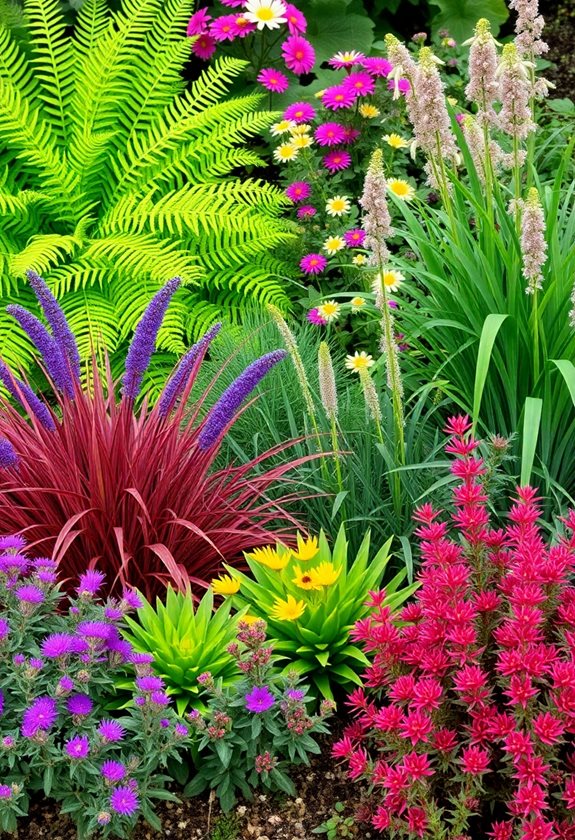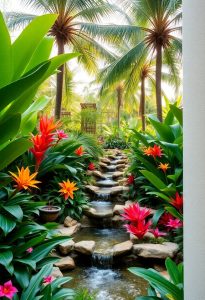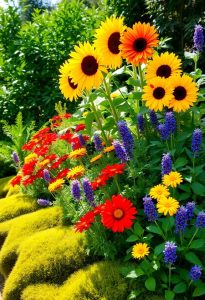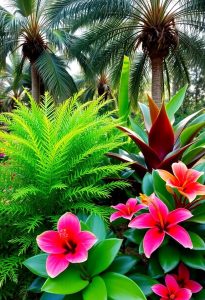If you’re dreaming of a lush garden, consider these five native plants that are sure to impress! First, the Purple Coneflower brings vibrant color and attracts bees. Next, Butterfly Milkweed offers stunning orange blooms and is essential for Monarchs. Black-eyed Susan adds cheerful yellow petals and thrives on neglect. Wild Bergamot fills the air with a lovely fragrance, appealing to pollinators, while Eastern Red Columbine attracts hummingbirds with its fiery blooms. Want some pro tips on pairing these beauties together?
Design Highlights
- Purple Coneflower: Attracts pollinators, thrives in full sun, and blooms from summer to fall, adding vibrant color to any garden design.
- Butterfly Milkweed: Bright orange blooms lure butterflies and provide food for Monarch caterpillars, thriving in sunny spots with well-drained soil.
- Black-eyed Susan: Cheerful yellow petals flourish in neglected areas, attracting pollinators and offering a lively atmosphere from summer to fall.
- Wild Bergamot: This aromatic perennial features lavender blooms, attracts beneficial insects, and enhances garden fragrance while requiring regular watering during dry spells.
- Eastern Red Columbine: With its striking red and yellow flowers, it attracts hummingbirds and thrives in partial shade, perfect for colorful spring gardens.
Purple Coneflower
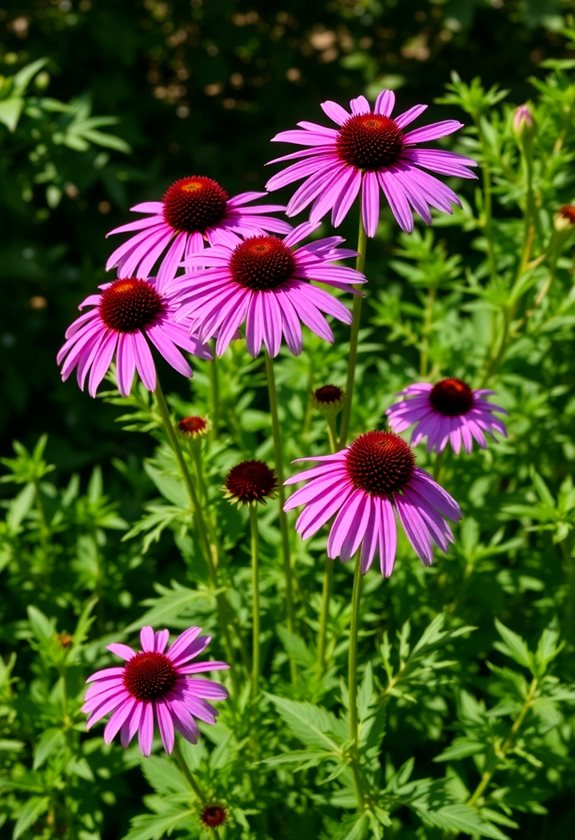
When you think about vibrant bursts of color in your garden, the Purple Coneflower is hard to overlook! This native perennial, with its striking purple petals and orange-brown cone, attracts both bees and butterflies. Want to make your garden pop? Plant them in groups for a stunning effect! They thrive in full sun and tolerate drought, making them low-maintenance—perfect for busy gardeners like you! Plus, they bloom from summer into fall, extending your garden’s beauty. Imagine sipping lemonade while watching butterflies flit about! So, are you ready to embrace the charm of the Purple Coneflower in your garden? Additionally, these flowers are considered best native flowers for enhancing local biodiversity and supporting pollinators.
Butterfly Milkweed
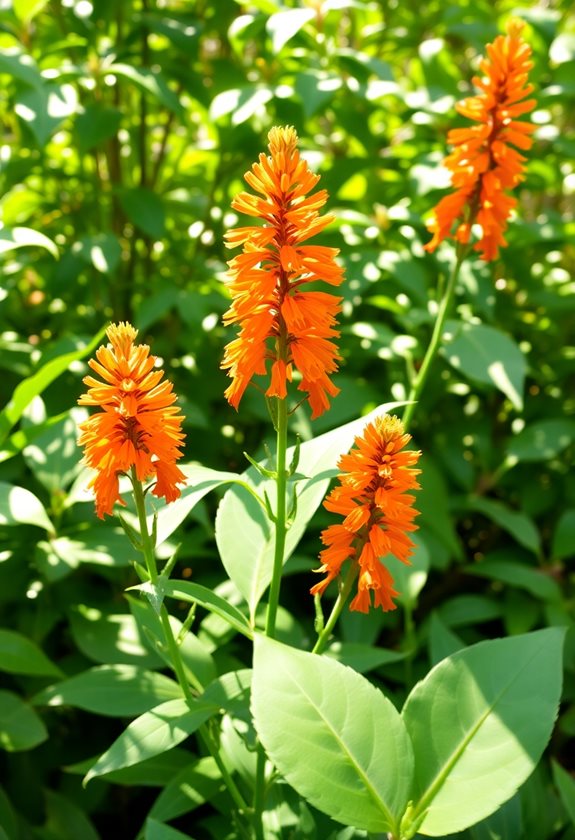
If you’re looking to attract even more butterflies to your garden, Butterfly Milkweed is a fantastic choice! This vibrant perennial not only dazzles with its orange blooms, but it’s also an essential food source for Monarch caterpillars. Imagine watching those beautiful butterflies fluttering around your yard! To plant, choose a sunny spot with well-drained soil. Water it regularly, especially during dry spells. Don’t forget to deadhead spent flowers to encourage new growth. Plus, it’s drought-resistant—how great is that? Additionally, it pairs beautifully with best plants for year-round garden color, making it a versatile addition to your landscape. Why not add a splash of color while supporting local wildlife? Your garden will thank you, and so will the butterflies!
Black-eyed Susan
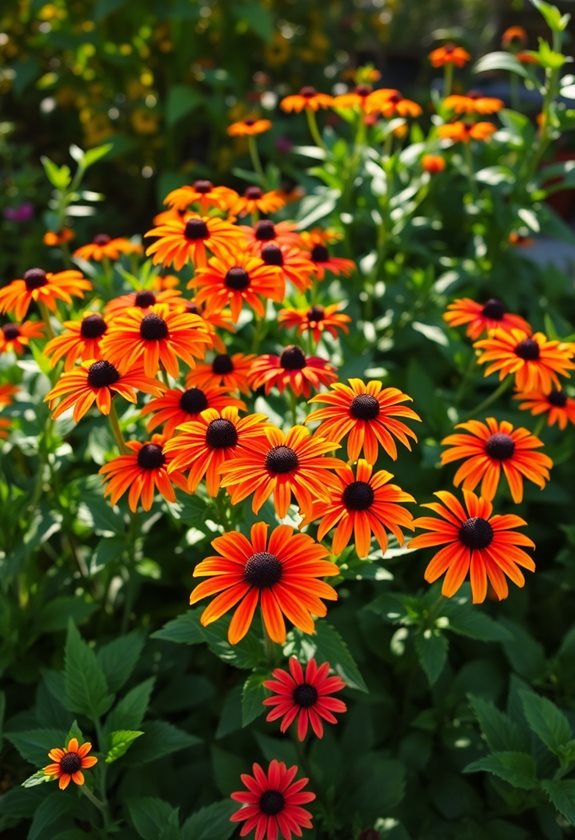
Picture a sunny day in your garden, with cheerful yellow petals bobbing in the breeze—that’s the magic of Black-eyed Susan! These vibrant beauties attract pollinators and add a splash of color. Want to plant them? Choose a sunny spot with well-drained soil. They thrive on neglect; just water them during dry spells and they’ll reward you with blooms from summer to fall. Plus, they’re drought-tolerant! Ever notice how they sway in the wind? It’s like nature’s dance party! So, why not invite Black-eyed Susan into your garden? You’ll love the cheerful vibe they bring—trust me, they’re a garden staple! Including best plants for lush garden design can create a stunning display that enhances your outdoor space.
Wild Bergamot

Though you might not realize it, Wild Bergamot can become your garden’s hidden gem! This aromatic perennial, with its lovely lavender blooms, attracts bees and butterflies, creating a vibrant ecosystem in your backyard. Imagine sipping tea made from its leaves—how cool is that?
To grow Wild Bergamot successfully:
- Choose a sunny spot with well-drained soil.
- Water regularly, especially during dry spells.
- Don’t forget to prune it back after blooming to encourage new growth!
With its delightful fragrance and pollinator-friendly qualities, Wild Bergamot not only enhances your garden’s beauty but also contributes to local wildlife. Additionally, it pairs beautifully with pollinator-friendly foliage plants, making it a perfect choice for a thriving garden. Ready to give it a try?
Eastern Red Columbine
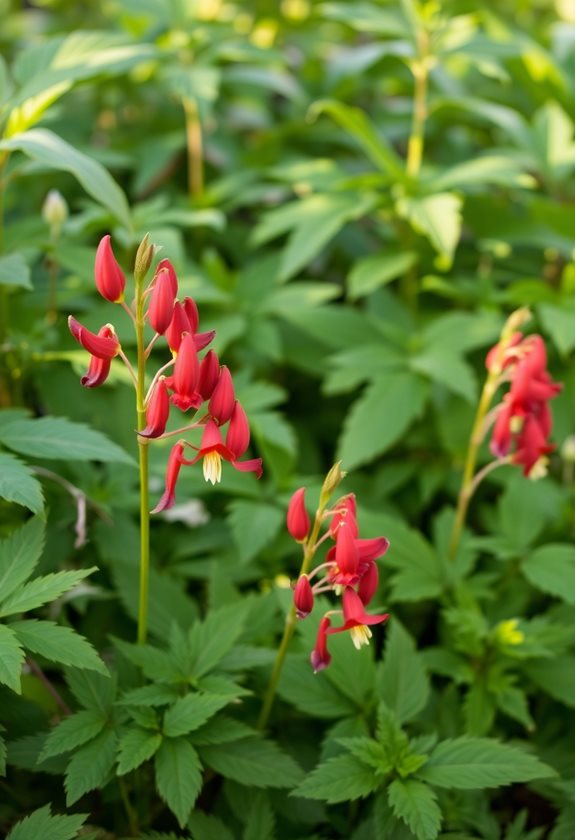
After enjoying the enchanting blooms of Wild Bergamot, you might be enthusiastic to add another stunning native plant to your garden: the Eastern Red Columbine. This alluring flower not only draws hummingbirds but also thrives in various conditions. You’ll love its delicate, drooping blossoms that flaunt a striking red and yellow color combination.
Here’s why you should consider Eastern Red Columbine:
- Attracts pollinators like birds and bees
- Thrives in partial shade and well-drained soil
- Adds vibrant color to your spring garden
- Low-maintenance and drought-tolerant
- Perfect for creating a natural privacy screen in your garden design
Ready to elevate your garden? You won’t regret it!
Frequently Asked Questions
How Do I Care for Native Plants in Drought Conditions?
Did you know that native plants can survive with up to 50% less water than non-natives? In drought conditions, focus on mulching to retain moisture and water deeply but infrequently. Observe your plants for signs of stress; if they’re wilting, it’s time to help! You can also group plants with similar water needs together. Remember, a little love goes a long way in keeping your garden thriving even when the sun’s blazing!
Can Native Plants Attract Beneficial Insects to My Garden?
Native plants can be your garden’s best friends when it comes to attracting beneficial insects. These plants provide the perfect food and habitat for pollinators like bees and butterflies, plus natural pest control with predatory insects. For example, planting coneflowers or milkweed can really draw them in! Why not give it a shot? You’ll not only beautify your space but also support the local ecosystem. It’s a win-win!
What Is the Best Time to Plant Native Flowers?
The best time to plant native flowers usually falls in spring or fall. Spring’s warmth encourages growth, while fall allows roots to establish before winter. Have you thought about starting seeds indoors a few weeks early? It’s a great way to get a jumpstart! Just make sure to check your local frost dates, so you don’t have any chilly surprises. Happy planting, and remember, patience is key—good things take time!
Do Native Plants Require Special Soil Types or Amendments?
Native plants are pretty adaptable, but they can thrive even better with the right soil! You don’t necessarily need special soil types, but some amendments might help. Here’s what you can do:
- Test your soil pH.
- Add organic matter, like compost.
- Guarantee good drainage.
These steps can boost growth and health. Remember, healthy plants equal a vibrant garden! Isn’t it exciting to see nature flourish right in your backyard?
How Can I Incorporate Native Plants in a Small Garden?
Incorporating native plants into a small garden can be a delightful challenge! Start by selecting a few key species that thrive in your area. Group plants with similar water and light needs to maximize space. Consider vertical options like climbing vines or tall grasses to add dimension. Don’t forget to leave some room for pathways—after all, you’ll want to stroll through your lush creation! Have fun experimenting, and enjoy the beauty of nature right at your fingertips!

